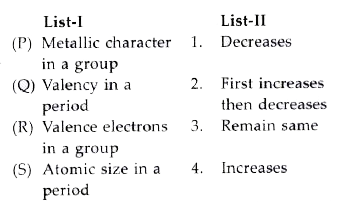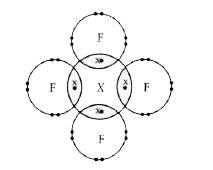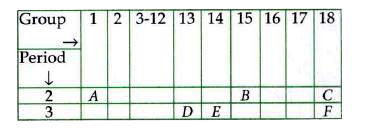Exercise (Subjective Problems) (Short Answer Type) from MTG IIT JEE FOUNDATION PERIODIC CLASSIFICATION OF ELEMENTS for Class 10
| Class 10 | CHEMISTRY |
| Chapter | PERIODIC CLASSIFICATION OF ELEMENTS |
| MTG IIT JEE FOUNDATION | Exercise (Subjective Problems) (Short Answer Type) |
| Medium | English |
| Academic Year | 2023-2024 |
Question 33
Listed below are the locations of certain elements in groups and periods of the periodic table. Arrange these elements in the expected order of increasing first ionisation energy.
P: Element in the fourth period and group IVA
Q: Element in the third period and group VIA
R: Element in the sixth period and group IIIA
S: Element in the second period and group VIIIA
T: Element in the fourth period and group VIAView SolutionQuestion 41
An element X combines with hydrogen to form a compound XH3. The element X is placed on the right side of the periodic table. What is true about the element X?
I. It has 2 valence electrons.
II It is a metal and is solid.
III. It is a non-metal and is a gas.
IV. it has 5 valence electrons
V. XH3 reacts with water to form a basic compoundView SolutionQuestion 64
Atoms of metals have only a few electrons in their valence shells while atoms of non-metals generally have more electrons in their valence shells. Metallic character is closely related to atomic radius and ionisation enthalpy. Metallic character increases from top to bottom in a group and decreases from left to right in a period. Metallic character is inversely related to electronegativity.
Which of the following groups contains metals, non-metals and metalloids?View SolutionQuestion 65
Atoms of metals have only a few electrons in their valence shells while atoms of non-metals generally have more electrons in their valence shells. Metallic character is closely related to atomic radius and ionisation enthalpy. Metallic character increases from top to bottom in a group and decreases from left to right in a period. Metallic character is inversely related to electronegativity.
Non-metals are present in the periodic table atView SolutionQuestion 66
Atoms of metals have only a few electrons in their valence shells while atoms of non-metals generally have more electrons in their valence shells. Metallic character is closely related to atomic radius and ionisation enthalpy. Metallic character increases from top to bottom in a group and decreases from left to right in a period. Metallic character is inversely related to electronegativity.
Considering the elements B, C, N, F and Si, the correct order of their non-metallic character isView SolutionQuestion 67
Metals have few electrons in their valence shell while non-metals generally have more electrons in their valence shell. Metallic character is closely related to atomic radius and ionisation enthalpy. Metallic character increases from top to bottom in a group and decreases from let to right in a period of periodic table. metallic character is inversely related to electronegativity of element.
Q. The electronegativity of the following elements increase in the order:View SolutionQuestion 68
Atoms of metals have only a few electrons in their valence shells while atoms of non-metals generally have more electrons in their valence shells. Metallic character is closely related to atomic radius and ionisation enthalpy. Metallic character increases from top to bottom in a group and decreases from left to right in a period. Metallic character is inversely related to electronegativity.
Considering the elements B, Al, Mg and K, the correct order of their ionisation potential isView SolutionQuestion 69
Atoms of metals have only a few electrons in their valence shells while atoms of non-metals generally have more electrons in their valence shells. Metallic character is closely related to atomic radius and ionisation enthalpy. Metallic character increases from top to bottom in a group and decreases from left to right in a period. Metallic character is inversely related to electronegativity.
The element with maximum electronegativity belongs toView SolutionQuestion 70
While going down in the group of non-metals (14, 15, 16 and 17) the electronegative character of non-metals decreases. Typical example is of group 15 elements. The elements nitrogen (2nd period) and phosphorus (3rd period) are non-metals and their oxides are acidic in nature. The elements arsenic (4th period) and antimony (5th period) are metalloids and their oxides are amphoteric in nature. However, bismuth (6th period) is a metal. Thus, we can see that the electronegative character (non-metallic character) of elements gradually decreases and ultimately the last element becomes metal. In case of group 17 of halogens, the first member of the group i.e., fluorine is most non-metallic in character and last member of group, i.e., astatine is least non-metallic in character. In other words, the electronegative nature of the elements decreases as we move down the group.
Which of the following is least metallic?View SolutionQuestion 71
While going down in the group of non-metals (14, 15, 16 and 17) the electronegative character of non-metals decreases. Typical example is of group 15 elements. The elements nitrogen (2nd period) and phosphorus (3rd period) are non-metals and their oxides are acidic in nature. The elements arsenic (4th period) and antimony (5th period) are metalloids and their oxides are amphoteric in nature. However, bismuth (6th period) is a metal. Thus, we can see that the electronegative character (non-metallic character) of elements gradually decreases and ultimately the last element becomes metal. In case of group 17 of halogens, the first member of the group i.e., fluorine is most non-metallic in character and last member of group, i.e., astatine is least non-metallic in character. In other words, the electronegative nature of the elements decreases as we move down the group.
Which of the following is the most metallic element?View SolutionQuestion 72
While going down in the group of non-metals (14, 15, 16 and 17) the electronegative character of non-metals decreases. Typical example is of group 15 elements. The elements nitrogen (2nd period) and phosphorus (3rd period) are non-metals and their oxides are acidic in nature. The elements arsenic (4th period) and antimony (5th period) are metalloids and their oxides are amphoteric in nature. However, bismuth (6th period) is a metal. Thus, we can see that the electronegative character (non-metallic character) of elements gradually decreases and ultimately the last element becomes metal. In case of group 17 of halogens, the first member of the group i.e., fluorine is most non-metallic in character and last member of group, i.e., astatine is least non-metallic in character. In other words, the electronegative nature of the elements decreases as we move down the group.
Which is the least electronegative element among the following ?View SolutionQuestion 73
While going down in the group of non-metals (14, 15, 16 and 17) the electronegative character of non-metals decreases. Typical example is of group 15 elements. The elements nitrogen (2nd period) and phosphorus (3rd period) are non-metals and their oxides are acidic in nature. The elements arsenic (4th period) and antimony (5th period) are metalloids and their oxides are amphoteric in nature. However, bismuth (6th period) is a metal. Thus, we can see that the electronegative character (non-metallic character) of elements gradually decreases and ultimately the last element becomes metal. In case of group 17 of halogens, the first member of the group i.e., fluorine is most non-metallic in character and last member of group, i.e., astatine is least non-metallic in character. In other words, the electronegative nature of the elements decreases as we move down the group.
Which of the following is the most non-metallic element?View SolutionQuestion 74
Numerous forms of the periodic table have been devised from time to time. A modern version, which is most convenient and widely used is the long or extended form of periodic table. The horizontal rows are called periods. There are altogether seven periods. The first period consists of 2 elements. The subsequent periods consist of 8, 8, 18, 18 and 32 elements respectively. Elements having similar outer electronic configurations in their atoms are grouped in vertical columns. These are referred to as groups or families. According to the recommendation of IUPAC, groups are numbered 1 to 18 replacing the older notation of group 0,IA, IIA, ....VIIA, VIII, IB, ......VIIB
An element belongs to group 17. It is present in third period and its atomic number is 17. What is the atomic number of the element belonging to same group and present in fifth period?View SolutionQuestion 75
Numerous forms of the periodic table have been devised from time to time. A modern version, which is most convenient and widely used is the long or extended form of periodic table. The horizontal rows are called periods. There are altogether seven periods. The first period consists of 2 elements. The subsequent periods consist of 8, 8, 18, 18 and 32 elements respectively. Elements having similar outer electronic configurations in their atoms are grouped in vertical columns. These are referred to as groups or families. According to the recommendation of IUPAC, groups are numbered 1 to 18 replacing the older notation of group 0,IA, IIA, ....VIIA, VIII, IB, ......VIIB
Elements in the same vertical group of the periodic table have generally the sameView SolutionQuestion 76
Numerous forms of the periodic table have been devised from time to time. A modern version, which is most convenient and widely used is the long or extended form of periodic table. The horizontal rows are called periods. There are altogether seven periods. The first period consists of 2 elements. The subsequent periods consist of 8, 8, 18, 18 and 32 elements respectively. Elements having similar outer electronic configurations in their atoms are grouped in vertical columns. These are referred to as groups or families. According to the recommendation of IUPAC, groups are numbered 1 to 18 replacing the older notation of group 0,IA, IIA, ....VIIA, VIII, IB, ......VIIB
Electronic configuration 2, 8, 1 is ofView SolutionQuestion 77
Numerous forms of the periodic table have been devised from time to time. A modern version, which is most convenient and widely used is the long or extended form of periodic table. The horizontal rows are called periods. There are altogether seven periods. The first period consists of 2 elements. The subsequent periods consist of 8, 8, 18, 18 and 32 elements respectively. Elements having similar outer electronic configurations in their atoms are grouped in vertical columns. These are referred to as groups or families. According to the recommendation of IUPAC, groups are numbered 1 to 18 replacing the older notation of group 0,IA, IIA, ....VIIA, VIII, IB, ......VIIB
In Mendeleev's periodic table, silver belongs to IB group. The group to which silver belongs in long form of periodic table isView SolutionQuestion 107
Chlorine is an element in period 3 of the Periodic Table. Bromine is found in period 4 of the Periodic Table. These two elements may be from different periods of the periodic table, but they have many similar properties.

Explain why the properties of chlorine and bromine closely resemble one another.View SolutionQuestion 108
Chlorine is an element in period 3 of the Periodic Table. Bromine is found in period 4 of the Periodic Table. These two elements may be from different periods of the periodic table, but they have many similar properties.

Lithium is an element from Group I of the Periodic Table. Write the formula of the compound formed between lithium and
(i) Chlorine (ii) Bromine (iii) What type of bonding is found in these compounds ? Give reason.View Solution
All Exercises from MTG IIT JEE FOUNDATION Class 10 CHEMISTRY PERIODIC CLASSIFICATION OF ELEMENTS
- NCERT SECTION
- EXERCISE (ASSERTION & REASON TYPE)
- EXERCISE (COMPREHENSION TYPE)
- EXERCISE (INTEGER/NUMERICAL VALUE TYPE)
- EXERCISE (MATCH THE FOLLOWING)
- EXERCISE (MULTIPLE CHOICE QUESTIONS LEVEL-1)
- EXERCISE (MULTIPLE CHOICE QUESTIONS LEVEL-2)
- EXERCISE (SUBJECTIVE PROBLEMS VERY SHORT ANSWER TYPE)
- EXERCISE (SUBJECTIVE PROBLEMS) (LONG ANSWER TYPE)
- EXERCISE (SUBJECTIVE PROBLEMS) (SHORT ANSWER TYPE)
- OLYMPIAD/HOTS CORNER
- ILLUSTRATIONS
- SOLVED EXAMPLES


















